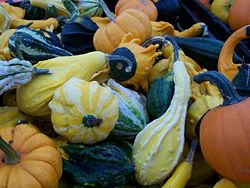Squash (food): Difference between revisions
imported>Petréa Mitchell (Illustration) |
imported>Petréa Mitchell m (Added subpages template) |
||
| Line 1: | Line 1: | ||
{{subpages}} | |||
[[Image:SquashGreensBridge2.jpg|right|thumb|250px|Squash come in an amazing variety of shapes.{{SquashGreensBridge2.jpg/credit}}]] | [[Image:SquashGreensBridge2.jpg|right|thumb|250px|Squash come in an amazing variety of shapes.{{SquashGreensBridge2.jpg/credit}}]] | ||
Revision as of 11:05, 14 October 2007
Squash are annual herbaceous plants of the genus Cucurbita, widely cultivated for their fruits, to feed both humans and animals.
Most cultivated varieties belong to the species C. maxima and C. pepo. The first originated in South America, the second in subtropical North America. Both species were major staple foods for pre-Columbian civilizations, which developed a huge range of varities from them.
Squash are functionally divided into summer and winter varieties. Summer squash are eaten immature, before the rind has hardened, and soon after harvesting, as they do not keep well. The blossoms of these squash are also sometimes eaten boiled or sautéed. This group includes zucchini, crookneck and straightneck squash.
"Winter squash" actually mature throughout the autumn or winter, depending on the variety. These squash are eaten fully mature, and can be kept for long periods of time for being used. This group includes pumpkins, acorn squash, butternut squash, and spaghetti squash. Most varities are baked, in or out of the rind, and the seeds of some are eaten as well.
Most squashes prefer a warm, dry summer and soil with a high organic content. Most squash plants are trailing, but some summer squashes form bushes.
